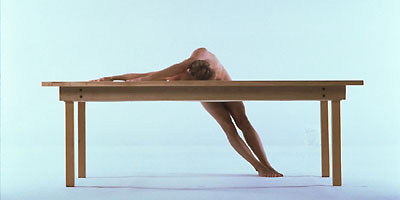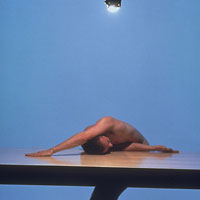Still Life N° 1 (1996)


If Still Life Nº 1 gives the power of speech to the body, analyzed and dissected in its countless gestures, it also gives speech to the being inside the body. In a suite of variations in which the body appears to take the leading role, a half-naked man and woman expose themselves on stage, literally and figuratively. Surrounded by a chair, an ash-blonde table lightened somewhat by a band of white paper suspended behind it, the two characters evolve. Their feet, backs, shoulders, hips, cheeks, arms, legs and hands reveal themselves in various movements, positions and attitudes. Something methodical is at work here – a science of the gesture taking us seamlessly from one movement to another, one figure to another – which permeates each minute of the work.
It is the very mechanics of the body which attracts the viewer’s attention, and which underpins the overall structure of Still Life Nº 1. The glances, the smiles, the brief poses and numerous manipulations of the body, however, indicate a relationship of complicity, more human than physical, more intimate than abstract. Within the sound environment created by Robert Normandeau, the bodies – posing, lying or sitting on the table, twisted or manipulated or launched into the air – trace out the trajectories of an experience shared by two individuals. In this encounter between human beings and an audience, a pure and omnipresent sensuality, ontologically defining for the body, gives Still Life Nº 1 a carnal dimension – the same one found in each man and in each woman.
With a soberness of style and intricacy of structure, the work reflects the multiformity of the body and of the human being in its natural state. The one and the many are reunited, embracing a story of sexual differentiation, man and woman, their physical relationship, their anatomy, and their infinite gestural possibilities.
Andrée Martin
Credits
Premiere: October 15, 1997, Klapstuk (Leuven, Belgium)
Choreographer
Lynda Gaudreau
Dancers
Sarah Doucet*
Mark Eden-Towle
Music
Robert Normandeau
Lighting design
Lucie Bazzo
Set design
Lynda Gaudreau,
assisted by Lucie Bazzo
A co-production of the Klapstuk (Leuven, Belgium) and the Compagnie De Brune.
Still Life N°1 (1996) was produced with the support of the Groupe de la Place Royale (Ottawa, Canada) and the Chapelle historique du Bon-Pasteur (Montreal, Canada), where Lynda Gaudreau and the Compagnie De Brune have done residencies.
Length: 60 minutes (without intermission)
*The female role was originally created with dancer Heather Mah.
Press Excerpts
Choreographer Lynda Gaudreau inhabits the intersection of dance and theatre, photography and painting. Very quietly, very cautiously. But so vividly that a new, self-contained form has come into being.
Malve Gradinger, Münchner Merkur (Germany), August 7, 1998
In Still Life Nº 1 (June 1996), Canadian choreographer Lynda Gaudreau, currently a guest of Tanzwerkstatt Europa, dissects the human body as if in an anatomy theatre [...].
[...] on the whole if the term "research into movement" that has come to be applied indiscriminately to every kind of investigation of movement has any meaning, it is here.
Katja Schneider, Süddeutsche Zeitung (Germany), August 7, 1998
In Still Life Nº 1, Canadian choreographer Lynda Gaudreau arranges the performers as objects apart from their natural surroundings, and strips them of all usual accessories and attitudes. She searches out the starkest situation possible, where the intention is not bravura, but subtlety. [...] Gaudreau's piece also sets forth this paradoxical quality: the more detailed a still life, with its apparently purely physical facts, the more clearly the signs of human nature stand out.
Edith Boxberger, Frankfurter Allgemeine Zeitung (Germany), November 28, 1997
With simplicity and directness, the opening [of Still Life Nº 1] uses the stage's power to emphasize objects: an image that may appear insignificant on the street here seems to indicate something essential.
Pierre T'Jonck, De Standaard (Belgium), October 19, 1997